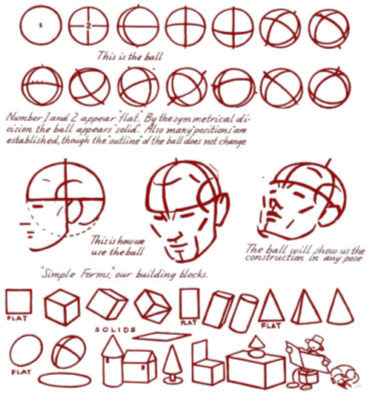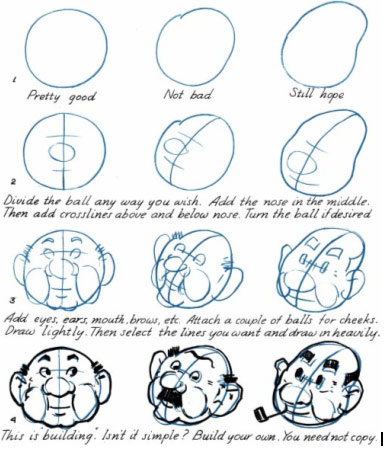| I say, “Draw a line.’’ You cannot know just what I mean. A straight line? A curved line? A jagged line? A wiggly line? There are a thousand kinds of lines; be more specific. But if I say draw a ball, a cube, an egg, a cylinder, a pyramid, a cone, a rectangular block, in each case the image you get is perfect. You know exactly what I mean. Instead of “line,’’ we shall think in terms of concrete and tangible “form,’’ and proceed as if we were handling lumps of clay. You can appreciate the value of such a method, for you know the fundamentals even before you start; they are obvious to anybody. If you never saw a ball, you should quit right now. As you proceed to build all sorts of shapes out of simpler ones, it is amazing what you can do with them, and how accurate and "solid’’ the resulting drawings will appear. The surprising part is that, when the construction lines are erased, very few could guess how it had been done. Your drawing appears us complicated and difficult to the other fellow as mine might seem to you now. A circle is a flat disk. If you draw the “inside” contours, it becomes a solid ball, with a third dimension. We shall build other forms, like lumps of clay, onto this solidity. The construction will be erased, but the solid appearance will remain, giving form or the appearance of reality. The simplest Forms we know are the sphere, the cube, and oval. |
 |
| Get a pencil and paper quickly! Draw lightly all you see printed in blue. Take one stage at a time, on one drawing, until the last stage; then finish, with strong lines over the light ones, the lines we have printed in black. That is all there is to learn! These are "selected’’ or "built in’’ from the basic forms. I call the basic drawings “Blocs,’’ after myself. I promised you that all you need to know, to start this book, is how to draw a lopsided ball. Whatever shape you draw can be used as a foundation for a funny face. Do the best you can, even if the ball looks more like a potato. |
 |
|
Our Courses
- Complete Applied Animation
- Game Designer
- Game Developer
- BG Animator
- Character Designer
- Java Training
- Joomla Training
- PHP Training
- SEO Training
- shell Scripting Training
- Develop Business through Social Media
- Artist Forum
- Little Animator
- Create Your Website
- Electronics and Microcontrollers
- Easy Software Developer
- Mobile Software Developer
- Vocational Training
- WebSphere Training
animation courses, Professional Animation Courses, 2D Animation, Internet, Cd-Presentation, Web development, Web Design, Multimedia Animation , Best Animation Academy India, Animation center india , Animation institute india , Animation training india, Animation classes india , Animations Classes India, Animation courses india , Animation training india , Animation School, Animation colleges , Animation college india , Animation university india, Animation degree india, 2d animation training india, 2d animation institute india, 2d animation courses india, Animation programs india , game development india, game design institute india, game design gaming india, gamedesign institute kolkata, gaming class india, gaming training india, Best web design Academy India, web design center india , web design School, web design institute india , Animation classes india , Animations Classes India, Animation courses india ,Animation training india , Animation college india , Animation university india, web design india, web design training india, 2d animation institute india, 2d animation courses india, web design institute india, Animation degress india , Animation training india, Best animation institute in India, Electronics and Embedded training at Kolkata, Hands on Training on Industrial Electronics and Embedded systems, For ITI, Diploma and Degree Engineering students, Real time projects and Industry interaction, Final year project guidance, Electronics and Embedded training at Kolkata, 1st Electronics and Embedded training in Eastern India
